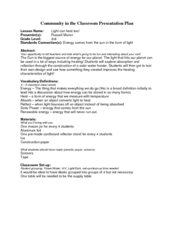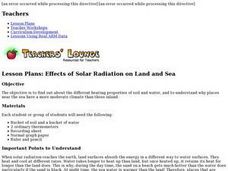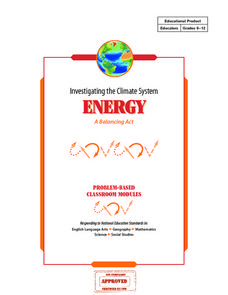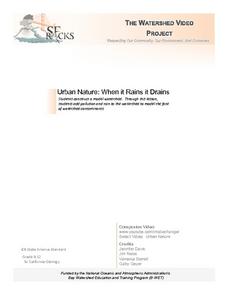National Institute of Open Schooling
Adsorption and Catalysis
Adsorption, not absorption, is when atoms stick to the surface of an object, like water sticking to a grain of sand. An informative lesson delves into adsorption, teaching physical and chemisorption and the factors that affect them....
CK-12 Foundation
Atomic Colors
Stars are too hot to visit, so how do we know what different stars are made of? An enlightening simulation uses a spectrum graph to show the various electron emission and absorption reactions. Scholars experiment with both helium and...
Colorado State University
What Does Color Have to Do with Cooling?
Study the rate of cooling for objects of different colors. Learners focus on the reflection and absorption of infrared light. Your classes may be surprised to learn objects that heat the slowest also cool the slowest.
Howard Hughes Medical Institute
Human Skin Color: Evidence for Selection
Skin color is controlled by at least six genes. Young scientists learn about skin colors through a documentary. They discuss the topics of pigment, natural selection, and vitamin D absorption. They apply their knowledge to higher order...
Curated OER
Conditioning and Storing Cut Flowers and Greens
Flower storage is an important topic if you are working with flowers. Consequently, this series of slides will be useful for those who are studying floral arranging. The information provided in this presentation could be used to enhance...
Center Science Education
Looking Into Surface Albedo
How does the color of a surface affect the heating of the earth? Middle school science classes experiment with color and surface albedo to determine the relationship. The website has tabs for an overview, teacher's instructions,...
Curated OER
Measuring the Number Of Calories In Sunlight
Learners., in groups, define calorie and compare the absorption of solar energy by three different collectors. They define solar constant and offer several explanations for discrepancies between the data collected and the solar constant.
Curated OER
Light Can Heat Too!
Third graders explore absorption and reflection of light energy. In this solar energy lesson, 3rd graders explore how light energy transfers to heat energy through the construction of a solar water heater. Students will discuss and...
Curated OER
Energy Resources
In this energy resources worksheet, learners read about the greenhouse effect and global warming. Then they explain why scientists are so concerned with greenhouse gases. Students also describe how global warming affects people worldwide.
Curated OER
Blinded by the Light
Students recognize that the colors they see are a result of the reflection of light. In this light and color lesson, students predict what color will be produced when lights are mixed. They identify the three primary colors and secondary...
Curated OER
Importance of Digestion
For this digestion worksheet, students complete statements using researched information about digestion and the digestive system. Students also sketch several figures that relate to digestion.
Cornell University
Light Waves: Grades 6-8
Explore the behavior of light with different materials. Collaborative groups determine whether certain materials absorb, reflect, diffract, or transmit light waves. They then measure the angle of incidence and angle of reflection.
Cornell University
Light Waves: Grades 9-12
Explore the behavior of light waves with a lab activity. Scholars build new vocabulary through experimentation and observation. Using different mediums, they model reflection, refraction, transmission, diffusion, and scattering of light.
US Department of Energy
Effects of Solar Radiation on Land and Sea
Earth science enthusiasts experiment to compare the heating rates of soil and water. They relate their findings to the weather conditions near bodies of water. Consider also having middle schoolers measure the cooling rates to...
Curated OER
Amazing Seeds
Three cute activities introduce youngsters to seeds and roots. In the first activity, various soaked seeds are placed in a glass so that the direction of root growth can be observed. In the second, a bag of seeds is filled with water and...
Curated OER
Investigating the Climate System: Energy, A Balancing Act
Earth science explorers design an experiment to demonstrate that the albedo of a surface affects its temperature. They test to find out if moisture on the surface affects temperature. They discover whether or not concrete or asphalt heat...
Curated OER
Organic Chemistry 231, Martin Larter, Exam 1
If you need a straightforward and comprehensive organic chemistry exam, check this one out. Chemistry pupils identify functional groups in molecule diagrams, draw a Lewis structure, fill in a table about molecular shape, predict boiling...
Curated OER
Dissolved Gases in Water
Using different types of water, earth science explorers set out to prove the ocean's ability to absorb greenhouse gases. They shake, heat, and freeze the water samples to examine gas content. This lesson is useful during a unit...
Curated OER
When It Rains it Drains
High schoolers examine the major paths of water on the Earth's surface, and to investigate the many factors that contribute to those paths. Students demonstrate their understanding of a watershed by identifying the defining features of a...
Curated OER
Strong Ice
Through three activities, first-time physical scientists wonder at the properties of water. Freeze some soda cans and a container of water prior to the investigation to show that water expands when frozen. Lab groups experiement with...
Cornell University
Shedding a "Little" Light on Cancer Surgery
Many types of cancer treatments now depend on nanotechnology—a big "little" discovery. Scholars begin by removing "malignant" tissue from simulated brains, one using fluorescent markers thanks to nanotechnology and one without. This...
DiscoverE
Waterproofing the Roof
Can your pupils build a roof that stands the test of time? Use an insightful engineering design project to highlight both materials science and architecture. Scholars either team up or work as individuals to design, create, and test a...
Curated OER
Solar Cooking
Students experiment with a virtual solar cooker to discover the mathematical relationship among reflection, transmission and absorption. Then they actually build and test a solar cooker of their own invention.
Curated OER
Wave Action
In this wave worksheet, students compare the different ways a wave can react: absorption, reflection, refraction, and diffraction. Students also read about constructive and destructive interference. This worksheet has 13 matching, 10...

























